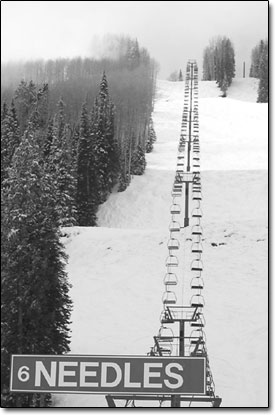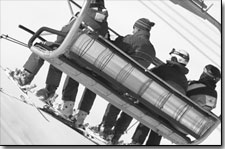|
Baby boomer hang on, and echo boomers enter the
scene
by Allen Best
 |
X-Rock, a popular climbing
area north of town on the flanks of Animas Mountain, and 2.45
acres surrounding it, was bought as open space in April 2001.
Durango’s Open Space Advisory Board is looking at ways
of securing a permanent fund that would go
toward the purchase of more open space, such as the X-Rock
parcel, in the future./Photo by Todd Newcomer. |
Many ski areas currently have the closed sign out. But behind
closed doors, ski area managers across the United States are looking
at better times. After sputtering for two decades, the industry
is finally growing once again. For ski areas, it’s not just
a matter of stealing market share from one another. The pie of
customers has actually been getting bigger, the first time since
baby boomers came of age 25 years ago.
Consider the last three years. There was terrorism. Stock market
pneumonia. And war – not once, but twice. These things should
have been disasters for the ski industry. Instead, the U.S. ski
industry had three of its four busiest seasons ever during this
time, the first prolonged growth since numbers began flattening
in 1979.
Population demographics have begun to favor the industry once
again. The 78 million baby boomers, now aged 40 to 58, are lingering
on the slopes longer than expected. They are more healthy and
vigorous than any generation before, and shaped skis combined
with improved grooming may keep them on boards 10 years longer
than originally expected.
Echo boomers, aged 21 and younger, are now dancing onto center
stage, about 71 million strong, providing nearly as much punch
as the original boomers. If the ski industry can get this generation
as interested in snow sports as their elders have been, the good
times will roll.
Michael Berry, president of the National Ski Area Association,
is upbeat. He traces the surge back to the 2000-01 season. From
the previous high of 54 million skiers in the United States that
had been the benchmark for a decade, the national tally leapt
to 57.3 million. Added to that were a record 14 million skiers
in Canada.
After the Sept. 11 attacks in 2001, the near halt in long-distance
travel and the stock market skid did not deflate skier numbers
as might have been expected. Instead, numbers held at 54 million.
Then, during the 2002-03 season, despite the outbreak of war against
Iraq in March, numbers jumped again to a new record of 57.6 million.
Berry says he wouldn’t be surprised if U.S skier numbers
surpassed 60 million within the next few years.
“We would expect this growth to continue for five to 10
years – that’s what the demographic data are telling
us,” says Berry.
Growth at small ‘urban’ areas
So far, nearly all the evidence for growth is found at smaller
ski areas near cities. A third of the 735 ski areas that existed
20 years ago have now closed, most of them smaller places, often
in places of marginal snow conditions. But now, the small ski
areas are thriving, and there are a few new ski areas.
Consider Colorado’s Eldora Mountain Resort, a smallish
ski area west of Boulder. A decade ago, Eldora was doing about
135,000 skiers annually, all of them day visitors from Colorado’s
Front Range. In the last several years, Eldora has been squeezed
by cheap season passes offered by Vail Resorts and Intrawest at
destination resorts not much farther away.
Still, by last year, Eldora’s numbers had essentially doubled
to almost 290,000 skier days, nearly the same as Aspen Mountain.
Such increased business is common at small ski areas close to
cities across the United States, reports Berry. They’re
doing so well that, at times – during school vacations,
holidays, after-school programs – there’s a capacity
problem.
Easily explained
All of this, says Berry, is easily explained.
“It’s all attributable to the demographic reality
that there are a lot of kids under 20,” he says. “We
expect to see this phenomenon continuing for between five and
10 years, and we have actually focused a lot of effort in the
industry to make sure we take full advantage of this opportunity.”
But Ford Frick, an economist and a principle in Denver-based
BBC Research and Consulting, argues that the industry may be growing
because it has broken free of its stuffiness. In his industry-commissioned
paper, “The American Ski Industry – Alive, Well and
Even Growing,” he argues that snowboards have been the key
agent of change.
 |
Skiers ride the DMR Six Pack earlier this
season. Ski area officals are lauding the
recent growth in skier numbers, saying that after years of
no growth, the sport
is growing again, thanks in part to the continued health of
baby boomers and the
so-called echo boomers, those age 21 and younger./Photo by
Todd Newcomer. |
“The introduction of snowboarding and the rapid rise in
telemark skiing, free skiing and a number of other equipment variations,
have been a breakthrough for the ski industry – not just
because they drew a new generation of participants, but because
they reminded an increasingly stodgy industry that ‘skiing’
was fundamentally about unstructured, outdoor recreation and the
individual freedom and adventure that it offers,” says Frick.
Vail, Crested Butte, Breckenridge – just about wherever
you go, the story is the same. Ski resorts are doing things that
were unimaginable a few years ago in an attempt to hang onto baby
boomers while reaching for the new crowd of what might be called
Xtylers.
Rainbow slopes
The ski industry does face a major challenge. If it is to grow,
it must broaden its appeal to a nation that is steadily becoming
more culturally and racially diverse.
In 1970, mid-way through the ski industry’s last boom,
whites made up 83 percent of the U.S. population. At the century’s
turn it was 69 percent. By mid-century, says the U.S. Census Bureau,
it will be 50 percent.
In the next 45 years, the Asian population is expected to triple.
But by far the largest minority group will be Hispanics, at about
25 percent of the U.S. population.
With such evidence in hand, Roberto Moreno, a Denver-based activist
and former ski patroller and instructor in Colorado’s Summit
County, says the ski industry must reach out to minorities.
“If we don’t, we will turn snow sports into polo,”
says Moreno.
“Last year’s jump to 57 million skier visits nationally
was an anomaly, and more the result of the proliferation of discount
season passes,” he maintains. “In fact, the actual
number of snow riders in America is decreasing. What isn’t
an anomaly is this country’s growing multicultural and gay
population.”
The ski industry, charges Moreno, has been only too successful
at marketing its exclusivity. It’s now time to become inclusive,
he insists.
When asked to talk about how to recruit minorities to skiing,
many people of varied backgrounds use the same words as if speaking
from a script. The industry, they say, must make the “invitation.”
Extending this hand to minority groups is not easy, say those
who market skiing, but neither is it rocket science. Mostly, it’s
hard work. The hand shake requires work by both ski area operators
and minorities.
Here and there are success stories. Aspen Skiing Co.’s
Chief Operating Officer David Perry recalls that when he was at
Whistler he helped attract Chinese skiers from Vancouver. The
key was working with group tour operators, he says, and then accommodating
the entire families, even if only the youngsters were learning
to ski and snowboard.
In California, Booth Creek’s Marketing Director Julie Mauer
reports a parallel program that has delivered Asian-Americans
to Northstar-at-Tahoe and Sierra. Studying California demographic
trends in the mid-1990s, Mauer noticed the rapidly increasing
number of immigrants from Asian among the Bay Area’s 11
million residents. Even more important, they had two key characteristics
of traditional skiers: They were highly educated and relatively
affluent.
Through targeted events, such as celebration of the Chinese New
Year, and target groups like social clubs that cater to Asian-Americans,
Mauer has increased the number of young Asian-American professionals,
called yappies, at the Tahoe resorts. From 2 or 3 percent a decade
ago, Asian-Americans now make up 15 percent of the customers at
Northstar and Sierra.
Asian-Americans were “not a particularly hard sell,”
says Mauer. “It’s just a matter of reaching out to
them. It’s not any harder than reaching out to Caucasians.”
More complex puzzle
Latinos, say marketing executives, are a more complex puzzle.
Moreno, now a consultant in such matters, advises the same approach
as with those who have succeeded by working with Asian-Americans.
The ski industry, he says, should establish ties through existing
social and professional groups, “inviting” them to
specific ski areas and into the sport in general. Both affluence
and education levels, note Hispanic activists, are rising.
But Moreno also argues for more diversity among the work force
at ski areas. Imagine going to a resort if you were white and
everybody else was black or Hispanic, suggests Moreno. You would,
at the very least, feel uncomfortable. Yet there are almost no
minorities in front-line positions at ski areas. Same goes for
marketing, such as websites, where minorities are almost nonexistent.
However, Moreno reports he is hearing some things from ski executives
that please him.
Big boys optimistic
Meanwhile, at Colorado’s largest destination resorts, optimism
rules. In Aspen, where there has been no growth at any of its
ski areas since 1992, Perry now predicts growth for five to 10
years.
At Vail Resorts, the story is the same. Adam Aron, chief executive
officer, says he’s far less worried about competition from
new resorts in British Columbia than about nearby competitors
in Colorado with their on-mountain improvements, expanded bed
bases and new base villages. Even so, his conclusion is the same.
“We’re bullish,” he says.
David Barry, senior vice president of Intrawest Colorado, which
operates Copper Mountain and Winter Park, is also upbeat after
double-digit gains in destination visitors this year. “There
are going to be shifts and changes, but I believe that the sport
is healthy, and the sport is evolving and the future is bright.”
|

